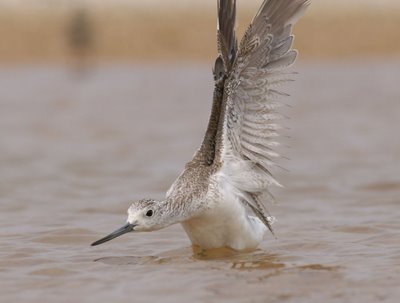
I couldn't zoom out on this Greenshank fast enough to get all the wings in, as it momentarily stretched, but it's still a nice pic I think. One day I hope to photograph a Nordmann's Greenshank doing the same thing, and showing a nice clean white pair of underwings!

An adult Pacific Golden Plover comes close.
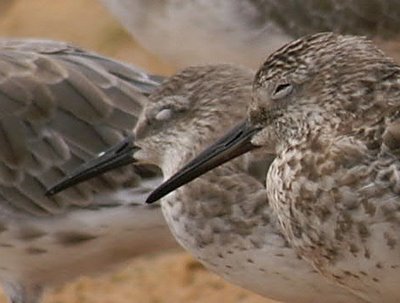
A close-up of Great (right) and Red Knots' heads, showing the difference in bill length and structure. Notice especially the distinctive nostril shape on each species.
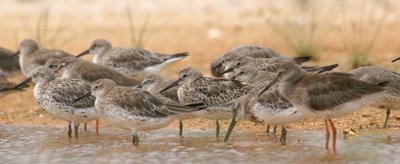
As knots of both species like to cluster together (in a tight 'knot'!), it can be difficult to get a good view of whole birds. So knowing the various 'bits' can be quite useful! By looking at the nostrils and other aspects, you should be able to spot 5 Red Knot in this group (though you'll need to click on the pic to enlarge it!).
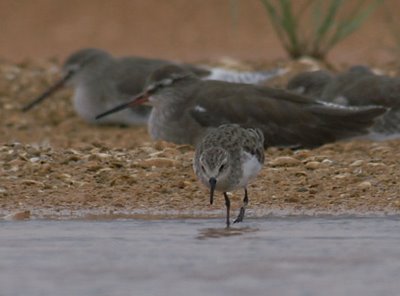
Oh boy! I almost dread finding one of these 'strange stints' again - getting a bad reputation for them! This bird looks very similar indeed to the one I photographed on Sept 26th (see that post), and could conceivably be the same bird (the old tertial has been replaced by a new one on this bird), though 10 days seems quite a long time for a migrating bird to hang around.

Back in the 1980s I used to see the odd Little Stint at Mai Po Marshes in Hong Kong in the spring migration. What struck me and other observers then was the difference in body, head and bill shape from Red-neckeds. Little have a more round shouldered, hump-backed appearance than the rather flat-backed silhouette of Red-necked. They have a pot-bellied appearance, and are generally more rotund than the slender-bodied Red-necked. The head seems to have a high forehead and then slope back to a rather rounded rear crown, in contrast to the rather square headshape of Red-necked. The bill is longer, finer-tipped, and slightly decurved, especially along the lower edge.

When feeding, I noticed this bird made more 'pecks per feeding movement' than the Red-neckeds, making it seem busier in its feeding style.
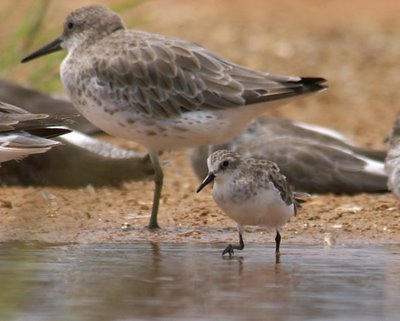
This picture gave me a shock when I saw it as it looks as though the bird's foot has partially webbed toes, which would make it Semi-palmated or Western Sandpiper. But, having enlarged it, I can't be sure that the effect is not produced by something other than webbing.

This picture shows the distinctive shape of this bird well - almost ball-shaped with a head and tail stuck on each end! Notice also the high forehead and domed crown. Is it a Little Stint? I think it probably is - I certainly can't see it as a Red-necked - but I can't be completely sure. I'd love to hear what others think!

As if one odd stint wasn't enough, I found another! This one still has many very worn breeding plumage feathers. It shows a similar head, body and bill shape to the other odd stint, but it seems to be quite a small individual.
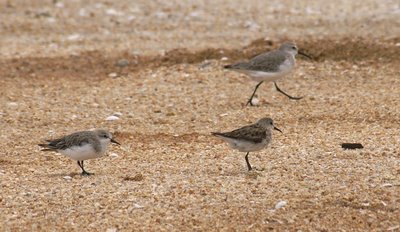
Here it is next to a typical non-breeding adult Red-necked (on the left). The differences in shape and jizz are pretty obvious! The mystery bird seems more 'leggy' than the Red-necked on the left, but this could just be an effect of the stance of the two birds.

Another view with a couple of Red-necked Stints (left). A(nother) Little? I don't know! Can anyone help???!!!
The day had already been an outstanding one when I noticed a tern that was clearly larger than the Little Terns flying around. I could only see it through the camo material on my hide, but by the size I assumed it was a Common Tern. Hoping it would land somewhere nearby I scanned the pool in front of me and eventually located it to my right. As soon as I got the camera focused on the bird I realized that this was not a Common Tern - the bill looked way too small.

I could also see that the central tail was dark smoke-grey, which ruled out any of the 'normal' terns. Looking at the ghost of a crown pattern on this bird, the incongruous thought came to me that this could be an Aleutian Tern!

The more I looked at the bird and checked off other possibilities, the more likely it seemed that this bird must be an Aleutian Tern. Sooty and Bridled Terns would show much darker, browner upperparts than this bird, as well as a more substantial bill.
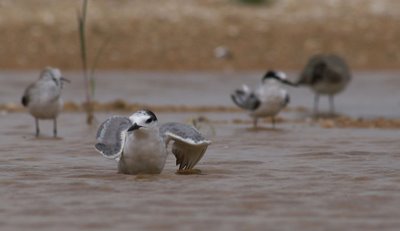
The bird showed a curious upperwing pattern, with a pale stripe along the middle of the wing, caused by pale-fringed median coverts, and a slightly darker carpal bar running along the leading edge of the wing.

The bird flapped its wings after bathing, showing a dark secondary bar on the underwing, which I later found is a fieldmark of Aleutian Tern.
The then took off and flew out of sight. A short time later, I decided to leave my hide, and, as I did so, found that the tern was the closest bird to me, sitting on the sand just to the right of my hide. It seemed reluctant to fly, so I was able to approach it and get some closer pictures from the side.

Some smokey-grey colouration can be seen on the sides of the neck. In breeding pluamge adults, the underparts are smokey-grey.
Realizing that I would need to get better flight views, I retreated to the car to get my telescope and binoculars, and then was able to watch the bird as it flew from the roost area to settle on the mudflats. I noted, among other things, that it had a grey central tail but a white rump. While it was on the mud I was able to take some sketches and notes. Once I got home I found that it wasn't easy to find out much about this species. All the photographs I could find are of adults in breeding plumage. The pictures of juveniles in The Sibley Guide to Birds appear to show a greyish tail and rump. My bird had a white rump (a feature of adults), so I would guess that it was somewhere in the moult process from a subadult plumage to adult. The longest primaries seemed to be worn, which would indicate that the bird is not a juvenile/1st winter, so my guess is that it is in its 1st summer/2nd winter.
Aleutian Terns breed on the coast and islands of Alaska and Eastern Siberia, and are now known to winter in the seas around parts of Indonesia. It is an oceanic species, rarely seen from land. I'm not sure of the status of the species in Malaysia. Some references suggest that it 'should occur' in Malaysian waters, but it isn't on any list of Malaysian birds I can find. In any event, it maybe the first record of this species on Malaysian soil!
No comments:
Post a Comment